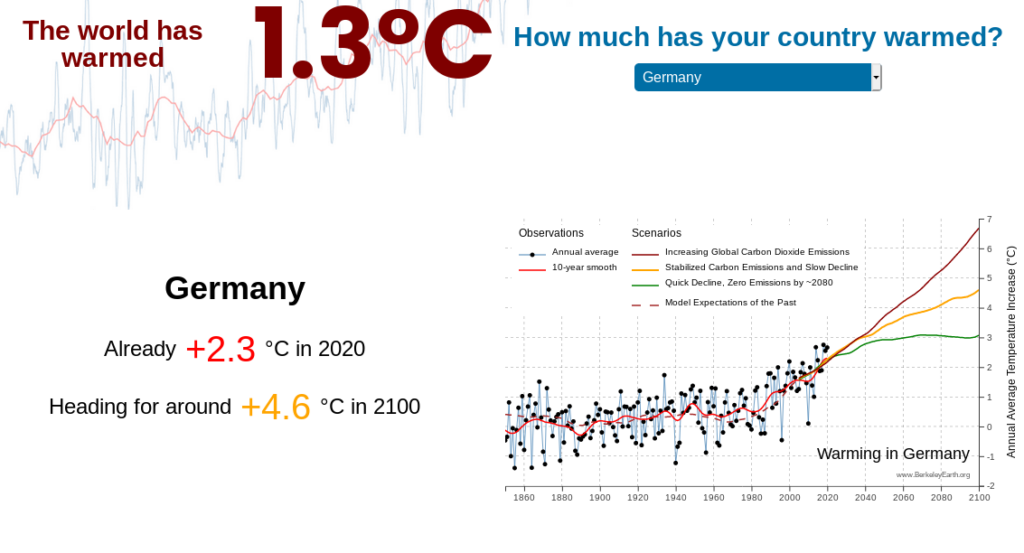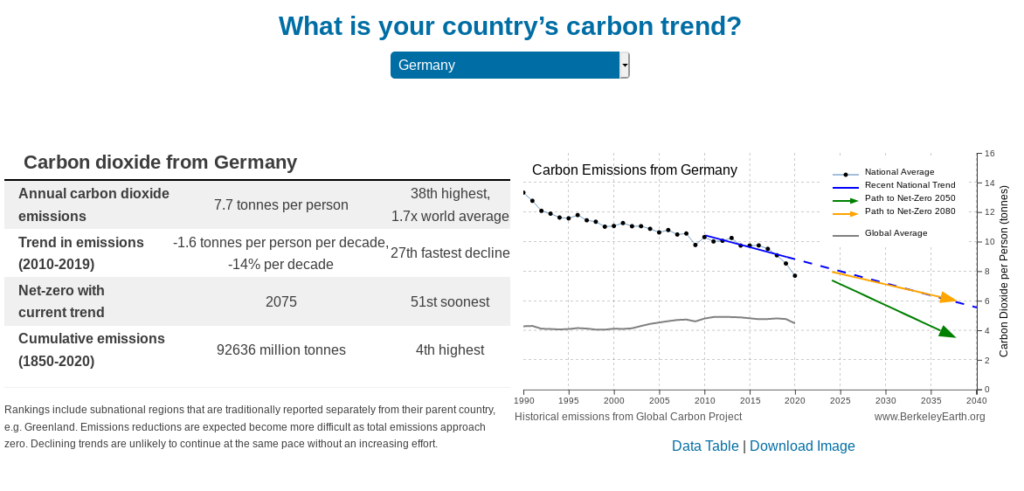(29.10.21, heise.de, berkleyearth.org ) , Hinweis beise heise : hier ; Original Berkleyearth : hier
NGO Berkeley Earth ein Onlinewerkzeug veröffentlicht, das einfach visualisiert, wie stark sich das Klima in jedem Land der Welt nach aktuellem Stand bis 2100 erwärmen wird. Die Werte liegen teilweise deutlich über den Prognosen für das weltweite Klima. Unter anderem, weil für Landmassen insgesamt eine stärkere Erwärmung als im globalen Durchschnitt erwartet wird, wie das verantwortliche Team erläutert. In Deutschland hat sich das Klima demnach gegenüber der vorindustriellen Ära bereits um 2,3 Grad Celsius erwärmt, bis 2100 seien 4,6 Grad Erwärmung zu erwarten. In Russland und Kanada beispielsweise sind es demnach sogar deutlich über 5 Grad.
Für Germany :


Veranschaulichung des CO2 – Kreislaufes : hier

The only way to reduce temperatures is to reduce carbon.
The burning of fossil fuels – oil, coal, and natural gas – is the primary source of man-made atmospheric carbon dioxide. Since the start of the industrial revolution, humans have contributed more than 2,000 billion metric tons of carbon dioxide to the atmosphere.
After it is released into the atmosphere, the carbon dioxide is naturally redistributed between the atmosphere, the oceans, and the biosphere. However, none of the emitted carbon will return to the Earth by natural processes for many tens of thousands of years. As a result, the carbon that humans release by burning fossil fuels will lead to increased levels of carbon in the atmosphere, ocean, and biosphere for many thousands of years.
If carbon dioxide is allowed to continue to accumulate in the atmosphere, it will be impossible for the world to stay below 2.0°C, let alone 1.5°C. The easiest way to avoid future warming is to rapidly decrease our use of fossil fuels, replacing them with low carbon alternatives such as wind, solar, hydro, and nuclear wherever possible.
A recent study found that 60% of remaining oil and methane (natural gas), and 90% of coal must stay in the ground if the world is to meet 1.5°C warming targets. For this to happen, oil and gas production would need to decline 3% annually through 2050.
The 2015 Paris Climate Agreement mandated that signatories set ambitious targets for their “nationally determined contributions” to reduce carbon emissions. Existing climate pledges, however, fall far short of the decarbonization necessary to meet warming targets: the NDC synthesis report published by UN Climate Change in February of 2021 found that national pledges would only reduce global emissions 12% by 2030, far short of the 45% required to meet 1.5°C, or 25% required to meet 2.0°C warming targets.

Verschiedene Szenarien möglich
Ergänzt werden die länderspezifischen Prognosen um historische Durchschnittstemperaturdaten, die bis zum Jahr 1850 zurückgehen. Hinzu kommen Vorhersagen für die Temperaturentwicklung in Szenarien weiter wachsender CO2-Emissionen, stabilisierter sowie langsam fallender Ausstöße und schnell fallender Emissionen. In Deutschland wäre demnach schlimmstenfalls eine Erwärmung um bis zu fast 7 Grad Celsius möglich, bestenfalls dagegen um 3 Grad. In Russland könnte demnach sogar eine durchschnittliche Klimaerwärmung von über 8 Grad Celsius erreicht werden. “Unsicherheit ist nicht unser Freund, vor allem wenn es um die echte Gefahr, katastrophaler Folgen geht”, erläutert der Klimawissenschaftler Zeke Hausfather den Zweck des Werkzeugs. Es zeige, dass es mit aktuellen Vorhaben schwierig sei, eine durchschnittliche Erwärmung um mehr als 4 Grad auszuschließen.
Hausfather weist zur Veröffentlichung des Werkzeugs nun aber auch darauf hin, dass einige der schlimmsten Szenarien wohl verhindert werden dürften. Es müsse aber noch viel unternommen werden. Damit schließt er sich einer Einschätzung der New York Times an, die unter Rückgriff auf Daten des Climate Action Trackers ermittelt hatte, dass seit dem Pariser Klimaschutzabkommen messbare Fortschritte erzielt wurden. So sei die Welt davor auf dem Weg zu einer durchschnittlichen globalen Erwärmung des Klimas um 3,6 bis 4,2 Grad Celsius (bis 2100) gewesen. Aktuell würde eine Erwärmung um 2,7 bis 3,1 Grad prognostiziert. Sollten abgegebene staatliche Versprechen umgesetzt werden, wären sogar 2,1 bis 2,4 Grad Erwärmung möglich. Auch das liegt aber noch deutlich über dem in der Wissenschaft formulierten maximal akzeptablen globalen Wert von 1,5 Grad Erwärmung.
Lesen Sie auch KI analysiert 100.000 Studien: Klimawandel trifft schon 85 Prozent der Menschen


